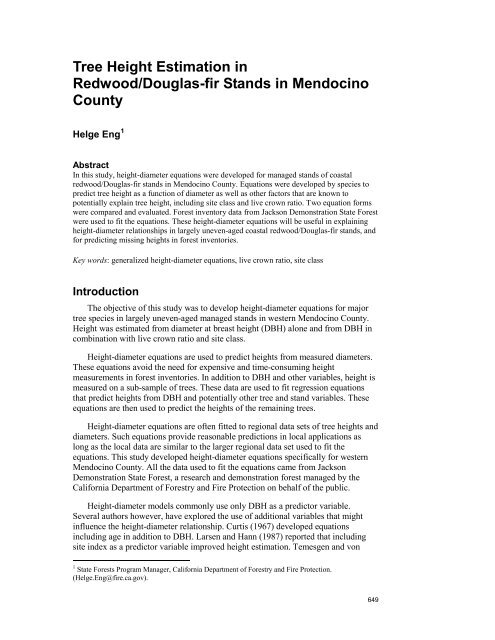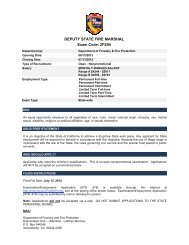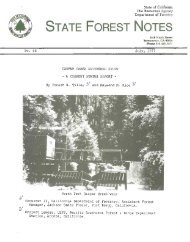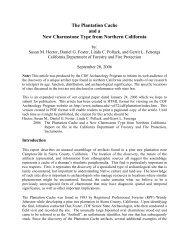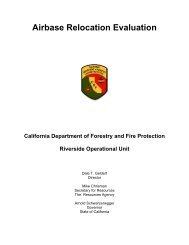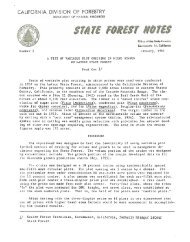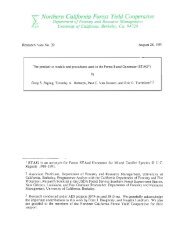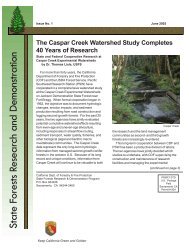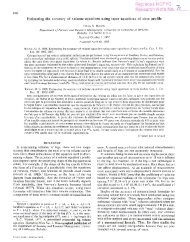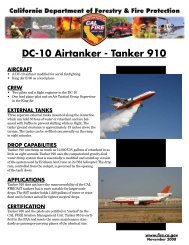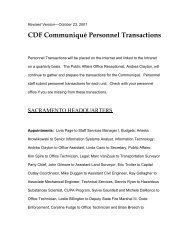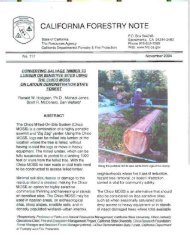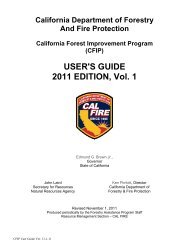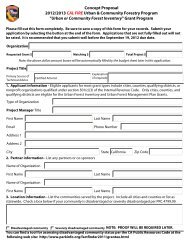Tree Height Estimation in Redwood/Douglas-fir Stands in ...
Tree Height Estimation in Redwood/Douglas-fir Stands in ...
Tree Height Estimation in Redwood/Douglas-fir Stands in ...
Create successful ePaper yourself
Turn your PDF publications into a flip-book with our unique Google optimized e-Paper software.
<strong>Tree</strong> <strong>Height</strong> <strong>Estimation</strong> <strong>in</strong><br />
<strong>Redwood</strong>/<strong>Douglas</strong>-<strong>fir</strong> <strong>Stands</strong> <strong>in</strong> Mendoc<strong>in</strong>o<br />
County<br />
Helge Eng 1<br />
Abstract<br />
In this study, height-diameter equations were developed for managed stands of coastal<br />
redwood/<strong>Douglas</strong>-<strong>fir</strong> stands <strong>in</strong> Mendoc<strong>in</strong>o County. Equations were developed by species to<br />
predict tree height as a function of diameter as well as other factors that are known to<br />
potentially expla<strong>in</strong> tree height, <strong>in</strong>clud<strong>in</strong>g site class and live crown ratio. Two equation forms<br />
were compared and evaluated. Forest <strong>in</strong>ventory data from Jackson Demonstration State Forest<br />
were used to fit the equations. These height-diameter equations will be useful <strong>in</strong> expla<strong>in</strong><strong>in</strong>g<br />
height-diameter relationships <strong>in</strong> largely uneven-aged coastal redwood/<strong>Douglas</strong>-<strong>fir</strong> stands, and<br />
for predict<strong>in</strong>g miss<strong>in</strong>g heights <strong>in</strong> forest <strong>in</strong>ventories.<br />
Key words: generalized height-diameter equations, live crown ratio, site class<br />
Introduction<br />
The objective of this study was to develop height-diameter equations for major<br />
tree species <strong>in</strong> largely uneven-aged managed stands <strong>in</strong> western Mendoc<strong>in</strong>o County.<br />
<strong>Height</strong> was estimated from diameter at breast height (DBH) alone and from DBH <strong>in</strong><br />
comb<strong>in</strong>ation with live crown ratio and site class.<br />
<strong>Height</strong>-diameter equations are used to predict heights from measured diameters.<br />
These equations avoid the need for expensive and time-consum<strong>in</strong>g height<br />
measurements <strong>in</strong> forest <strong>in</strong>ventories. In addition to DBH and other variables, height is<br />
measured on a sub-sample of trees. These data are used to fit regression equations<br />
that predict heights from DBH and potentially other tree and stand variables. These<br />
equations are then used to predict the heights of the rema<strong>in</strong><strong>in</strong>g trees.<br />
<strong>Height</strong>-diameter equations are often fitted to regional data sets of tree heights and<br />
diameters. Such equations provide reasonable predictions <strong>in</strong> local applications as<br />
long as the local data are similar to the larger regional data set used to fit the<br />
equations. This study developed height-diameter equations specifically for western<br />
Mendoc<strong>in</strong>o County. All the data used to fit the equations came from Jackson<br />
Demonstration State Forest, a research and demonstration forest managed by the<br />
California Department of Forestry and Fire Protection on behalf of the public.<br />
<strong>Height</strong>-diameter models commonly use only DBH as a predictor variable.<br />
Several authors however, have explored the use of additional variables that might<br />
<strong>in</strong>fluence the height-diameter relationship. Curtis (1967) developed equations<br />
<strong>in</strong>clud<strong>in</strong>g age <strong>in</strong> addition to DBH. Larsen and Hann (1987) reported that <strong>in</strong>clud<strong>in</strong>g<br />
site <strong>in</strong>dex as a predictor variable improved height estimation. Temesgen and von<br />
1<br />
State Forests Program Manager, California Department of Forestry and Fire Protection.<br />
(Helge.Eng@<strong>fir</strong>e.ca.gov).<br />
649
650<br />
GENERAL TECHNICAL REPORT PSW-GTR-238<br />
Gadow (2004) used measures of stand density and relative tree position. The average<br />
height and diameter of the largest trees <strong>in</strong> the stand, a measure of top height, has been<br />
used by Hanus et al. (1999) and Krumland and Wensel (1988).<br />
Methods<br />
Data<br />
Because the objective of this study was to characterize the height-diameter<br />
relationship <strong>in</strong> managed stands, no stands were excluded from the analysis due to<br />
management activity. The majority of the data used <strong>in</strong> this study (table 1) were<br />
collected on Jackson Demonstration State Forest (JDSF) <strong>in</strong> western Mendoc<strong>in</strong>o<br />
County dur<strong>in</strong>g the 2005 field season. The data <strong>in</strong>clude a temporary plot <strong>in</strong>ventory<br />
consist<strong>in</strong>g of 4,920 plots located on a 5 cha<strong>in</strong> (330 ft) by 20 cha<strong>in</strong> (1,320 ft) grid<br />
across the Forest, and 143 permanent plots located on a 60 cha<strong>in</strong>s by 60 cha<strong>in</strong>s grid<br />
across the Forest. Only the 2005 remeasurement data were used from the permanent<br />
plot data set. Data used to fit madrone and western hemlock equations also <strong>in</strong>cluded<br />
additional data from a 1991 JDSF temporary plot <strong>in</strong>ventory, which had the same<br />
design as the 2005 temporary plot <strong>in</strong>ventory.<br />
Table 1—Description of the data used to fit height-diameter equations.<br />
Species <strong>Tree</strong>s<br />
Mean<br />
DBH<br />
(<strong>in</strong>ches)<br />
Std.<br />
Dev.<br />
M<strong>in</strong> Max<br />
Mean<br />
<strong>Height</strong><br />
(feet)<br />
Std.<br />
Dev.<br />
M<strong>in</strong> Max<br />
<strong>Redwood</strong> 2,235 24.0 10.6 5.1 76.3 107.4 36.8 19.0 244.0<br />
<strong>Douglas</strong>-<strong>fir</strong> 1,567 23.8 10.5 5.1 61.3 126.8 43.6 24.0 241.0<br />
Grand <strong>fir</strong> 225 22.1 10.1 5.2 50.2 121.2 42.2 28.0 217.0<br />
Western 234 14.7 6.2 5.2 39.7 89.6 27.4 32.0 168.0<br />
hemlock<br />
Tanoak 819 13.3 5.9 5.0 43.3 60.4 18.5 18.0 122.0<br />
Madrone 527 13.4 5.5 5.8 36.2 58.7 15.4 15.0 107.0<br />
The 1991 and 2005 temporary plot <strong>in</strong>ventory consisted of variable radius plots<br />
with a concentric 1/100th ac fixed area regeneration plot on the same plot center. The<br />
variable radius plots <strong>in</strong>cluded trees 5.0 <strong>in</strong> DBH and greater. The cont<strong>in</strong>uous forest<br />
<strong>in</strong>ventory permanent plots, <strong>fir</strong>st <strong>in</strong>stalled <strong>in</strong> 1959, were one-fifth acre circular plots.<br />
The m<strong>in</strong>imum DBH measured was 7.0 <strong>in</strong>. The most common tree species on JDSF<br />
<strong>in</strong>clude coast redwood, <strong>Douglas</strong>-<strong>fir</strong>, grand <strong>fir</strong>, western hemlock, tanoak and madrone.<br />
Analysis<br />
Two sets of height-diameter equations were developed. The <strong>fir</strong>st set of equations<br />
estimated height us<strong>in</strong>g DBH as the only predictor variable. The second set of<br />
equations estimated height as a function of DBH <strong>in</strong> comb<strong>in</strong>ation with other tree or<br />
stand variables. In addition, two model forms were used. This produced four model<br />
forms to be evaluated for each species. The model form that provided the best fit was<br />
selected for each height-diameter equation for each species.<br />
The follow<strong>in</strong>g equations were fitted to the data:
<strong>Tree</strong> <strong>Height</strong> <strong>Estimation</strong> <strong>in</strong> <strong>Redwood</strong>/<strong>Douglas</strong>-<strong>fir</strong> <strong>Stands</strong> <strong>in</strong> Mendoc<strong>in</strong>o County<br />
1. <strong>Height</strong> = 4.5 + exp(a + bDBH c )<br />
2. <strong>Height</strong> = 4.5 + a(1 – exp(bDBH c ))<br />
3. <strong>Height</strong> = 4.5 + exp(a0 + a1ASC + bDBH c )<br />
4. <strong>Height</strong> = 4.5 + exp(a0 + a1ASC + a2LCR + bDBH c )<br />
Other predictor variables used <strong>in</strong> addition to DBH <strong>in</strong>cluded:<br />
Aggregated site class (ASC). ASC was a b<strong>in</strong>ary variable <strong>in</strong> which the value 1 denoted<br />
site class II or better, and the value 0 denoted site class III or less productive.<br />
Live crown ratio (LCR). LCR is the percent of the bole of a tree that conta<strong>in</strong>s live<br />
crown. This measurement consisted of a visual estimate by cruisers. Two sides were<br />
averaged <strong>in</strong> the case of non-uniform crown length.<br />
Temesgen et al. (2007) found equation 1 to be the best equation when us<strong>in</strong>g DBH<br />
as the only predictor variable. The equation 1 model form was also used by Hanus et<br />
al. (1999) and Larsen and Hann (1987). Unlike equation 1, equation 2 is downward<br />
concave, with no <strong>in</strong>flection po<strong>in</strong>t. Huang et al. (1992) found equation 2 to give the<br />
best results.<br />
Equation parameters were estimated us<strong>in</strong>g a nonl<strong>in</strong>ear least squares estimation<br />
procedure with the Gauss-Newton estimation method. The STATISTICA software<br />
(StatSoft 2011) was used to fit all equations.<br />
Results<br />
Table 2 shows the coefficients and their standard error of estimate <strong>in</strong> parentheses,<br />
root mean squared error (MSE) and coefficient of determ<strong>in</strong>ation (R 2 ) for equations 1<br />
and 2. MSE is the square root of the division of the sum of squared residuals by the<br />
degrees of freedom. R 2 is the proportion of the variation expla<strong>in</strong>ed by the regression<br />
(regression sum of squares divided by the total sum of squares).<br />
Equations were evaluated for predictive ability us<strong>in</strong>g the MSE, R 2 , the t-statistic<br />
of the coefficients and their confidence <strong>in</strong>tervals. Plots of residuals versus predicted<br />
heights <strong>in</strong>dicated no lack of fit.<br />
651
652<br />
GENERAL TECHNICAL REPORT PSW-GTR-238<br />
Table 2—Regression coefficients and standard errors for equations 1 and 2, by species. The<br />
best fit is shown for each species. All parameter estimates were significantly different from<br />
zero (p
<strong>Tree</strong> <strong>Height</strong> <strong>Estimation</strong> <strong>in</strong> <strong>Redwood</strong>/<strong>Douglas</strong>-<strong>fir</strong> <strong>Stands</strong> <strong>in</strong> Mendoc<strong>in</strong>o County<br />
Table 4—Regression coefficients and standard errors for equation 4, by species. The best fit<br />
is shown for each species. All parameter estimates were significantly different from zero<br />
(p
654<br />
GENERAL TECHNICAL REPORT PSW-GTR-238<br />
Huang, S.; Titus, S.J.; Wiens, D.P. 1992. Comparison of nonl<strong>in</strong>ear height-diameter<br />
functions for major Alberta tree species. Canadian Journal of Forest Research 22:<br />
1297-1304.<br />
Krumland, B.K.; Wensel, L.C. 1988. A generalized height-diameter equation for coastal<br />
California species. Western Journal of Applied Forestry 4: 113-115.<br />
Larsen, D.R.; Hann, D.W. 1987. <strong>Height</strong>-diameter equations for seventeen tree species <strong>in</strong><br />
Southwest Oregon. Research Paper 49. Corvallis, OR: Forest Research Laboratory,<br />
Oregon State University. 16 p.<br />
StatSoft Inc. 2011. STATISTICA. Version 10. www.statsoft.com.<br />
Temesgen, H.; von Gadow, K. 2004. Generalized height-diameter models for major tree<br />
species <strong>in</strong> complex stands of <strong>in</strong>terior British Columbia, Canada. European Journal of<br />
Forest Research 123: 45-51.<br />
Temesgen, H.; Hann, D.W.; Monleon, V.J. 2007. Regional height diameter equations for<br />
major tree species of southwest Oregon. Western Journal of Applied Forestry 22: 213-<br />
219.


